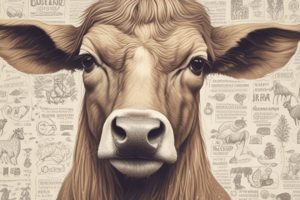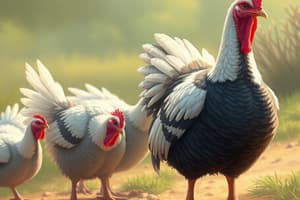Podcast
Questions and Answers
Which of the following strategies is LEAST effective in preventing the spread of highly contagious viral diseases like foot and mouth disease among livestock?
Which of the following strategies is LEAST effective in preventing the spread of highly contagious viral diseases like foot and mouth disease among livestock?
- Maintaining high standards of hygiene in animal shelters and disposal of waste.
- Allowing limited contact between herds to build natural immunity. (correct)
- Implementing strict quarantine measures for infected animals.
- Regularly vaccinating livestock against common viral strains.
In a dairy farm aiming to maximize milk production while ensuring animal welfare, which approach would be MOST beneficial?
In a dairy farm aiming to maximize milk production while ensuring animal welfare, which approach would be MOST beneficial?
- Prioritizing cost-cutting measures in feeding and healthcare to increase profit margins.
- Implementing rigorous milking schedules without regard for animal comfort.
- Focusing solely on high-yielding breeds while neglecting nutritional needs.
- Balancing the selection of high-yielding breeds with proper feeding, regular health check-ups, and hygienic practices. (correct)
What is the PRIMARY reason for implementing artificial insemination in animal breeding programs?
What is the PRIMARY reason for implementing artificial insemination in animal breeding programs?
- To decrease the genetic diversity within a breed.
- To facilitate the widespread use of superior sires and control diseases. (correct)
- To limit the use of superior sires to a small geographic area.
- To increase the occurrence of undesirable traits in offspring.
Which of the following actions would be MOST effective in managing and preventing coccidiosis in a poultry farm?
Which of the following actions would be MOST effective in managing and preventing coccidiosis in a poultry farm?
Why is proper waste management particularly crucial in animal farming?
Why is proper waste management particularly crucial in animal farming?
In fish farming, what is the MOST important reason for maintaining optimal water quality?
In fish farming, what is the MOST important reason for maintaining optimal water quality?
What is the PRIMARY benefit of crossbreeding in animal husbandry?
What is the PRIMARY benefit of crossbreeding in animal husbandry?
Which feeding strategy would BEST support the health and productivity of cattle and buffaloes?
Which feeding strategy would BEST support the health and productivity of cattle and buffaloes?
What is the purpose of quarantining animals?
What is the purpose of quarantining animals?
Which of the following strategies is MOST important in preventing Newcastle disease in poultry farms?
Which of the following strategies is MOST important in preventing Newcastle disease in poultry farms?
Flashcards
Selective breeding
Selective breeding
Choosing parents with desirable traits to produce offspring with those traits.
Artificial insemination
Artificial insemination
Semen is collected from a male and artificially introduced into a female, allowing for wider use of superior sires and helps in controlling diseases.
Crossbreeding
Crossbreeding
Mating animals of different breeds to combine desired traits from both breeds, leading to hybrid vigor.
Regular vaccination (livestock)
Regular vaccination (livestock)
Signup and view all the flashcards
Quarantine measures
Quarantine measures
Signup and view all the flashcards
Foot and mouth disease
Foot and mouth disease
Signup and view all the flashcards
Anthrax
Anthrax
Signup and view all the flashcards
Poultry farm management
Poultry farm management
Signup and view all the flashcards
Dairy farm management
Dairy farm management
Signup and view all the flashcards
Study Notes
- Animal husbandry involves the management and breeding of domestic animals for economic purposes
- It includes taking care of animals by providing them with shelter, food, healthcare, and protection
- Key aspects include breeding, feeding, and disease control
Breeding
- The goal of animal breeding is to improve the genetic qualities of livestock
- Selective breeding involves choosing parents with desirable traits to produce offspring with those traits
- Artificial insemination is a technique where semen is collected from a male and artificially introduced into a female
- This allows for wider use of superior sires and helps in controlling diseases
- Crossbreeding involves mating animals of different breeds to combine desired traits from both breeds
- It can lead to hybrid vigor, where the offspring are superior to both parents in certain traits
Feeding
- Proper feeding is crucial for the health and productivity of livestock
- Animal feed should be nutritious and balanced, providing all essential nutrients
- Nutrients include carbohydrates, proteins, fats, vitamins, and minerals
- Cattle, buffaloes, and other ruminants require a diet rich in fiber, such as hay and silage
- Poultry requires a diet rich in proteins and vitamins for growth and egg production
- Feed supplements, such as mineral mixtures and vitamin supplements, are often added to the diet
Disease Prevention
- Disease prevention is essential for maintaining healthy livestock and preventing economic losses
- Regular vaccination protects animals from various infectious diseases
- Maintaining clean and hygienic conditions in animal shelters reduces the risk of disease outbreaks
- Proper disposal of animal waste helps prevent the spread of pathogens
- Quarantine measures are used to isolate sick animals and prevent the spread of disease to healthy animals
- Regular deworming is necessary to control internal parasites
- Common diseases of livestock include foot and mouth disease, anthrax, and mastitis
- Foot and mouth disease is a highly contagious viral disease affecting cloven-footed animals
- Anthrax is a bacterial disease that can affect all warm-blooded animals
- Mastitis is an inflammation of the mammary gland, commonly seen in dairy animals
- Poultry diseases include fowl pox, coccidiosis, and Newcastle disease
- Fowl pox is a viral disease that causes skin lesions and respiratory problems
- Coccidiosis is a parasitic disease that affects the intestines
- Newcastle disease is a highly contagious viral disease affecting poultry
Management of Farm Animals
- Proper housing provides protection from weather and predators
- Regular cleaning and disinfection of animal shelters are essential
- Adequate ventilation is necessary to maintain air quality and prevent respiratory diseases
- Proper waste management minimizes the risk of disease and environmental pollution
- Regular inspection of animals helps in early detection of diseases
- Gentle handling reduces stress and improves animal welfare
Dairy Farm Management
- Dairy farm management involves the efficient production of milk and milk products
- Selection of high-yielding breeds is crucial for maximizing milk production
- Proper feeding ensures adequate milk production and maintains animal health
- Regular health check-ups and vaccinations prevent diseases
- Cleanliness and hygiene are essential for producing high-quality milk
- Proper storage and transportation of milk prevent spoilage and contamination
Poultry Farm Management
- Poultry farm management involves the efficient production of eggs and meat
- Selection of appropriate breeds is crucial for maximizing egg or meat production
- Proper feeding ensures optimal growth and egg production
- Maintaining hygienic conditions prevents disease outbreaks
- Regular vaccination protects against common poultry diseases
- Proper handling of eggs and meat prevents contamination and spoilage
Fish Farming (Pisciculture)
- Fish farming involves the cultivation of fish in controlled environments
- Selection of appropriate fish species is crucial for successful fish farming
- Proper water quality management is essential for fish health and growth
- Adequate feeding ensures optimal growth and production
- Disease prevention is important for maintaining healthy fish populations
- Harvesting and processing of fish should be done carefully to maintain quality
Bee Keeping (Apiculture)
- Bee keeping involves the management of honeybee colonies for honey and beeswax production
- Selection of appropriate bee species is crucial for successful bee keeping
- Providing suitable bee hives and equipment is essential
- Protecting bees from diseases and pests is important
- Harvesting honey and beeswax should be done carefully to avoid harming the bees
Animal Products
- Milk is a nutritious food rich in proteins, fats, vitamins, and minerals
- Meat is a good source of protein and essential nutrients
- Eggs are a good source of protein and vitamins
- Honey is a natural sweetener with medicinal properties
- Wool is used for making clothing and textiles
- Leather is used for making shoes, bags, and other products
Studying That Suits You
Use AI to generate personalized quizzes and flashcards to suit your learning preferences.




